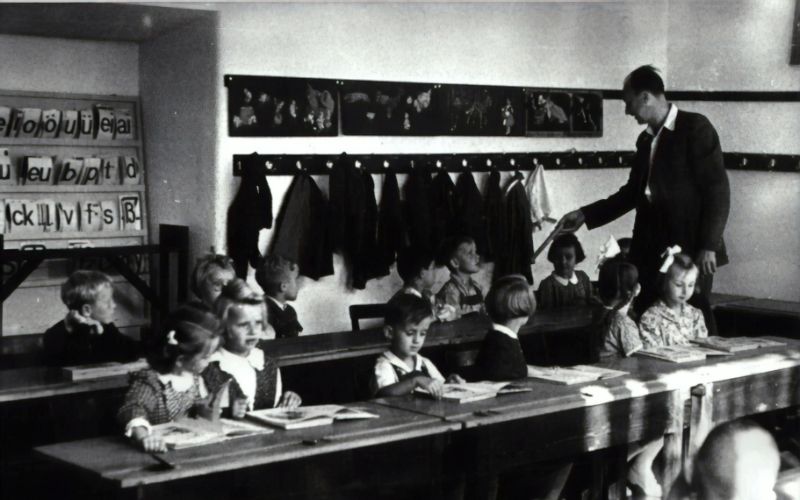
Principal leadership styles shape a school’s culture and success. Discover the key leadership styles and how they can transform your school.
Key Takeaways
- Principal leadership styles, particularly transformational and instructional, are crucial in shaping school culture and enhancing student achievement.
- Adapting leadership styles to the unique needs of each school environment, while fostering collaboration and continuous improvement, leads to better educational outcomes.
- Professional development, mentorship, and self-evaluation are essential for principals to refine their leadership skills and effectively lead their school communities.
Understanding Principal Leadership Styles
Principal leadership styles are the linchpin in the complex machinery of a school’s environment, directly influencing the effectiveness of educational reforms and academic performance. Leadership choices resonate through the hallways, impacting everything from classroom management to creating safer and more productive learning spaces.
Among the various styles, transformational leadership stands out, characterized by principals who inspire and motivate their staff towards a shared vision, fostering a positive shift in school culture. Effective leadership forms the foundation for the success of any educational institution.
Key Principal Leadership Styles in Education
In the diverse landscape of educational leadership, several principal leadership styles emerge as particularly influential. These include:
- Transformational
- Instructional
- Democratic
- Transactional
- Authoritative
- Laissez-faire
Each style brings unique strengths to the table, whether it’s the collaborative spirit of a democratic leader or the structured guidance of a transactional one.
Successful school leaders prioritize student learning, foster a positive atmosphere, and adeptly manage the complexities of a school environment. Understanding these key leadership styles can help inspire and uplift your school community.
Transformational Leadership Style
Transformational leadership is all about looking beyond individual self-interests to achieve a common goal. As transformational leaders, principals focus on:
- Encouragement and skill development
- Creating an environment where teachers feel supported and motivated to excel
- Leading by example
- Engaging deeply with their teams
- Fostering a culture of collaboration and shared vision
A transformational leader cares deeply about the success of their employees, working tirelessly to raise academic expectations and championing the belief that every student can succeed. Encouraging teachers to achieve their personal goals and valuing everyone’s opinions, transformational leaders cultivate a school culture invested in a shared vision of success.

Instructional Leadership Style
Instructional leadership focuses on the essence of education: teaching quality. Principals using this style aim to improve teaching practices and enhance student learning outcomes. They guide teachers through professional development, helping them refine their instructional methods and align with the school’s educational goals.
Instructional leaders believe that by lifting the quality of teaching, they directly improve student performance and foster a more effective learning environment where students learn.
Democratic Leadership Style
Democratic leadership, also known as participative leadership, places a high value on involving teachers in the decision-making process. This approach fosters a collaborative environment where teachers feel their opinions are valued and their contributions matter. Principals who practice democratic leadership create an inclusive culture that improves results and ensures all voices in the school community are heard.
Encouraging proactive and joint decision-making, democratic leaders foster a sense of ownership among staff and students. This inclusive approach boosts teacher morale and leads to better educational outcomes as everyone works towards common goals.
Studies have shown that the democratic leadership style receives high positive perceptions among teachers, highlighting its effectiveness in fostering a supportive and engaged school environment.
Transactional Leadership Style
Transactional leadership is characterized by clear expectations and a structured approach to managing performance. Principals who use this style rely on rewards and consequences to influence teacher behavior and performance. This traditional approach ensures that teachers understand their roles and responsibilities, with straightforward job descriptions and expectations.
Managing performance with a system of rewards for compliance and consequences for non-compliance, transactional leaders ensure order and accountability within the school.
Authoritative Leadership Style
Authoritative leadership is especially effective during times of change or crisis. Principals who adopt this style set high standards and provide clear guidelines. They offer strong, decisive leadership that establishes stability and clarity, which is crucial when navigating through challenging periods.
Setting high expectations and providing clear direction, authoritative leaders can significantly boost the overall performance and morale of the school community.
Laissez-Faire Leadership Style
Laissez-faire leadership styles offer a high degree of autonomy to teachers while the principal remains accountable for the overall results. This style is practiced at a moderate level by some college principals and involves minimal direct involvement in decision-making.
While granting teachers the freedom to innovate and take initiative, it also demands strong accountability to ensure educational goals are met.
Impact of Principal Leadership Styles on School Performance
The impact of principal leadership styles on school performance cannot be overstated. Different leadership styles can greatly enhance the learning environment, particularly in high-poverty areas. Effective school leadership transforms average schools into successful ones, significantly boosting standardized test scores and other performance metrics. A principal’s leadership style sets the tone for the entire building, influencing organizational climate, teacher satisfaction, and student outcomes.
These leadership styles specifically enhance teacher performance, foster a positive school culture, and promote student achievement.
Enhancing Teacher Performance
Leadership styles profoundly impact teacher performance. Democratic leadership addresses teachers’ emotional behavior, creating a supportive and inclusive environment. Instructional leadership aligns with teachers’ values and emotional needs, leading to better instructional practices and increased job satisfaction.
Principals who set high expectations and involve teachers in decision-making foster a sense of ownership and commitment, significantly enhancing teacher performance. Providing opportunities for professional growth and development is crucial for maintaining high teaching standards.
Fostering Positive School Culture
Creating a positive school culture is integral to effective school leadership. The alignment of a principal’s leadership style with the school’s mission fosters a cohesive and supportive environment. Democratic leadership encourages shared decision-making, fostering a sense of ownership among teachers and students.
Transformational leadership can instill visionary practices that reshape the school culture, leading to enhanced teacher engagement and student participation. A culture of high expectations for all members of the school community contributes to a positive and productive learning environment.
Promoting Student Achievement
Leadership styles play a critical role in promoting student achievement. Principals who focus on instructional leadership directly impact student performance in core subjects like mathematics and English language arts. Effective school leaders create a supportive and engaging learning environment, significantly influencing how students perceive their education and their level of engagement.
Fostering a supportive culture for teachers and students enables principals to drive significant improvements in student outcomes and overall school performance.
Adapting Leadership Styles to School Needs
Adapting leadership styles to the unique needs of a school is crucial for effective school leadership. Understanding the distinct needs of the school environment allows principals to tailor their approach accordingly. Effective school leaders engage in adaptive leadership, navigating ongoing changes in the educational landscape to drive improvements in school performance.
Next, we will explore how to assess the school environment, balance multiple leadership styles, and emphasize continuous improvement.
Assessing School Environment
A thorough assessment of the school environment is the first step in choosing the right leadership style. Principals must evaluate their own strengths and weaknesses, as well as the specific challenges and needs of their school. Understanding the situational context allows leaders to adapt their approach to be more effective.
For instance, the authoritative leadership style is particularly effective during major changes or when staff performance needs to be addressed.
Balancing Multiple Styles
Balancing multiple leadership styles can lead to more effective school leadership. Transactional leaders, for example, should blend their approach with other styles to avoid the pitfalls of strict rule adherence. Involving teachers and staff in decision-making fosters a sense of community and empowerment.
Instructional leaders emphasize autonomy, believing that teachers do not need to be micromanaged. Empowering others within the school by cultivating future leaders among teachers, parents, and administrators is essential for a thriving school environment.
Continuous Improvement
Continuous improvement is a cornerstone of effective school leadership. Education leaders should focus on ongoing learning and self-improvement to enhance their effectiveness. Data analysis plays a crucial role in finding new ways to improve student achievement.
Successful principals understand that preparing others to lead does not weaken their own leadership but rather strengthens the entire school community.
Developing Leadership Skills for Principals
Developing leadership skills is essential for both aspiring and current principals. Fine-tuning these skills can significantly impact their effectiveness in leading a school. Professional development, mentorship, and self-evaluation are key components of this process.
The following sections will delve into these strategies, highlighting the importance of continuous learning, building a strong professional network, and regularly assessing one’s leadership practices.
Professional Development
Commitment to continuous professional education is crucial for principals to stay informed about the latest leadership strategies. Ongoing training and education help school leaders remain current in their practices and enhance their leadership skills.
Early-career mentorships can significantly boost professional growth by providing guidance and support from experienced leaders.
Mentorship and Networking
Mentorship and networking are invaluable for both aspiring and current principals. Mentors provide guidance, share their experiences, and help new principals build confidence in their leadership abilities.
Building a robust professional network through workshops, conferences, and professional organizations allows principals to share best practices, discuss challenges, and find collaborative solutions. Networking can lead to mentorship opportunities, significantly enhancing a principal’s effectiveness and professional growth.
Self-Evaluation and Feedback
Regular self-evaluation and feedback from peers and staff are essential practices for refining leadership strategies. Self-reflection helps leaders identify areas for personal growth, while feedback from staff provides valuable insights into their effectiveness.
Engaging in these practices ensures that principals remain adaptable and responsive to the needs of their school community, ultimately enhancing overall school performance.

Case Studies of Effective Principal Leadership
Real-world examples of effective principal leadership offer valuable insights into the successful implementation of different styles. Case studies show how visionary leadership transforms school culture, instructional leadership enhances teaching quality, and democratic leadership fosters collaboration.
These stories of successful principals showcase the tangible benefits of employing various leadership styles and serve as inspiration for educational leaders striving to make a difference in their schools.
Transformational Leadership in Action
Dr. Enfield’s experience with transformational leadership highlights the power of a shared vision in building community trust. Faced with a trust issue, Dr. Enfield used ThoughtExchange to create a fair process for gathering community feedback, addressing the challenge of low participation in traditional surveys.
This innovative approach allowed the community to express their concerns and priorities, ultimately leading to a successful bond passage and a stronger, more cohesive school community.
Instructional Leadership Success
An exemplary case of instructional leadership is seen in a principal who focused on creating a collaborative culture to enhance teaching and learning. By setting clear teaching objectives, supporting professional growth, and utilizing data to track student progress, this principal significantly improved student learning outcomes and fostered a positive school environment.
This approach demonstrates the effectiveness of instructional leadership in driving academic success.
Democratic Leadership in Practice
A principal who embraced democratic leadership involved teachers and staff in the decision-making process, promoting a sense of ownership and collaboration within the school. This inclusive approach led to improved teacher morale, enhanced student engagement, and better overall performance.
This case study illustrates how democratic leadership creates a supportive and dynamic school culture, benefiting both teachers and students.
Wrapping Up
Choosing the right leadership style is crucial for the success of a school. Whether it’s the visionary approach of transformational leadership, the focus on teaching quality in instructional leadership, or the inclusive nature of democratic leadership, effective school leadership can significantly impact academic performance and school culture. By understanding and adapting these styles to meet the unique needs of their schools, principals can inspire their communities and drive educational excellence. Remember, the journey of leadership is continuous, and the commitment to learning and growth will pave the way for a brighter future in education.
For those looking to enhance their leadership skills and foster a positive school culture, consider exploring the services offered by 220 Youth Leadership. They provide valuable resources and programs designed to empower educational leaders to make a lasting impact. Visit 220 Youth Leadership to learn more and take the next step in your leadership journey.
Frequently Asked Questions
Why are principal leadership styles important?
Principal leadership styles are important because they significantly impact school culture, educational innovation, and student achievement. Effective leadership fosters a positive environment that enhances learning outcomes.
What is transformational leadership in education?
Transformational leadership in education is about inspiring and motivating staff to achieve a shared vision, which enhances school culture and elevates academic performance expectations. It emphasizes the importance of fostering a collaborative and supportive environment for both educators and students.
How does instructional leadership improve student learning?
Instructional leadership significantly improves student learning by enhancing teaching practices and fostering teacher development, ultimately leading to better educational outcomes for students. Effective leaders prioritize instructional quality and support educators in their professional growth.
What are the benefits of democratic leadership in schools?
Democratic leadership in schools enhances collaboration and inclusion, leading to improved teacher morale and increased student engagement. This participatory approach empowers educators and students alike, fostering a positive school culture.
How can principals adapt their leadership styles to their school's needs?
Principals can effectively adapt their leadership styles by thoroughly assessing the school environment and implementing a balanced approach that prioritizes continuous improvement. This strategy allows them to address unique challenges and enhance overall school performance.
